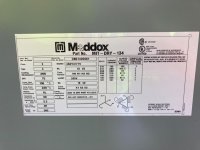We have a Step Up 75KVA transformer 208 to 480V, configured Delta-Wye, feeded from a 150A sub-feed 3-phase breaker in a panel 42 ft away.
The secondary load is an equipment panel with a 100A 3-phase main disconnect, 10ft away from the transformer. No neutral.
Do we need a disconnect for the transformer?
The secondary load is an equipment panel with a 100A 3-phase main disconnect, 10ft away from the transformer. No neutral.
Do we need a disconnect for the transformer?

